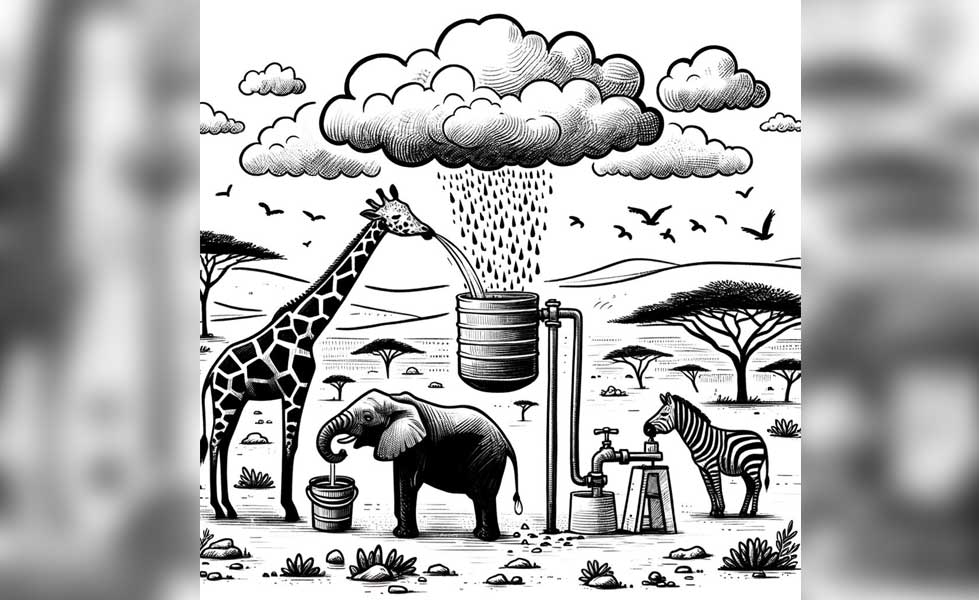Rainwater harvesting, a sustainable solution to water scarcity, is increasingly vital in Kenya. This newsletter offers an exhaustive look into rainwater harvesting, covering its essence, operational dynamics, practical applications, regulatory framework, and an evaluation of its strengths and challenges. In Kenya, where water scarcity affects both urban and rural populations, rainwater harvesting is not just an alternative but a necessity. It represents a synergy between traditional knowledge and modern technology, providing a lifeline in drought-prone areas. As climate change exacerbates water scarcity, the significance of rainwater harvesting in Kenya’s water strategy is ever more pronounced.
What is Rainwater Harvesting?
Rainwater harvesting in Kenya encompasses the collection, storage, and utilization of rainwater from surfaces like rooftops, land areas, and rock catchments. It’s an ancient practice, revitalized to combat modern water challenges. This method stands out in Kenya’s diverse landscapes, from arid regions to bustling urban centres, offering a buffer against water scarcity. By capturing rainwater, Kenyans can reduce their reliance on erratic natural water sources and overburdened municipal systems. This practice not only secures water supply but also fosters a culture of resourcefulness and sustainability, aligning with global environmental conservation goals.
How Rainwater Harvesting Works
Rainwater harvesting in Kenya is a systematic process beginning with collection from impervious surfaces. These systems, designed to maximize water capture, include gutters, downspouts, and conduits that guide water to storage units. Sophisticated setups may feature filtration and first-flush devices to improve water quality before it reaches storage tanks. These reservoirs, often underground or above ground, are engineered to preserve water quality and quantity against evaporation and contamination. The stored water, after undergoing necessary treatment processes like filtration and disinfection, becomes a versatile resource. This end-to-end process exemplifies a harmonious blend of traditional practices and modern engineering, showcasing Kenya’s innovative approach to sustainable water management.
Usage of Rainwater Harvesting in Kenya
In Kenya, rainwater harvesting transcends basic water collection; it integrates into various facets of life. Beyond domestic chores, it sustains agricultural ventures, supporting both small-scale family farms and larger agribusinesses. In urban areas, it alleviates pressure on municipal water systems, providing a supplementary source during shortages. Industrial sectors leverage this resource, reducing operational costs and enhancing sustainability. Additionally, rainwater harvesting plays a critical role in ecological balance, aiding in groundwater recharge and reducing urban heat island effects. Its versatility and adaptability make it a cornerstone of Kenya’s water conservation efforts, illustrating the potential for rainwater to be a key player in the nation’s sustainable development.
Legislative Framework Governing Rainwater Harvesting in Kenya
Kenya’s legislative environment for rainwater harvesting is comprehensive, aiming to integrate RWH into the national water management strategy effectively. The Water Act 2016 serves as the cornerstone, supplemented by various policies and initiatives that encourage rainwater harvesting practices. These legal frameworks are designed to ensure equitable access, efficient usage, and sustainable management of water resources. County-level policies further tailor the approach to local needs, fostering community engagement and ownership. The government’s commitment to reinforcing rainwater harvesting through legal means demonstrates a proactive approach to securing water for all sectors of society, highlighting the role of policy in achieving water sustainability.
Pros of Rainwater Harvesting in Kenya
Rainwater harvesting in Kenya stands as a beacon of sustainability, offering numerous advantages. It provides a dependable water source during periods of drought and reduces the strain on traditional water supplies. Economically, it lessens the financial burden on households and governments by curtailing the need for extensive water supply infrastructure. Environmentally, it curtails runoff, preventing soil erosion and reducing the risk of flood events. Socially, it empowers communities, providing them with the autonomy to manage their water resources effectively. These benefits collectively fortify Kenya’s resilience to environmental and socio-economic challenges, underscoring the multifaceted value of rainwater harvesting.
Cons of Rainwater Harvesting in Kenya
Despite its benefits, rainwater harvesting in Kenya faces several challenges. The upfront cost of installing comprehensive harvesting systems can deter individuals and communities from adoption. Moreover, the efficacy of these systems hinges on regular and effective maintenance, which can be resource-intensive. Quality assurance of the harvested water is another significant concern, necessitating robust treatment and monitoring mechanisms to safeguard public health. Additionally, the viability of rainwater harvesting is intrinsically linked to climatic conditions, making it susceptible to the vagaries of weather patterns and climate change. These challenges underscore the need for strategic planning, investment, and innovation to fully harness the potential of rainwater harvesting in Kenya.
Possible Solutions
To address the challenges associated with rainwater harvesting in Kenya, several solutions can be implemented. Firstly, to mitigate the high initial costs, the government and non-governmental organizations can offer subsidies, grants, or low-interest loans for installing rainwater harvesting systems. Educational programs can be developed to train individuals and communities on low-cost, sustainable rainwater collection and storage techniques. Regular maintenance can be ensured through community-based programs that train locals to manage and upkeep their systems effectively, thus ensuring long-term functionality and efficiency. To tackle water quality concerns, strict guidelines and standards for water treatment should be established, along with promoting simple, cost-effective water purification methods at the household level. Finally, to reduce dependency on inconsistent rainfall, integrated water resource management approaches should be adopted. These could include combining rainwater harvesting with other water-saving measures like greywater recycling and efficient irrigation practices, thus ensuring a more reliable and diversified water supply.
Conclusion
Rainwater harvesting is a key strategy for sustainable water management in Kenya, offering solutions to the pressing challenges of water scarcity and climate change. While it presents certain drawbacks, these can be mitigated through strategic interventions, policy support, and community engagement. Embracing rainwater harvesting can significantly enhance Kenya’s water resilience, ensuring a sustainable and secure water future. As the country moves forward, the integration of technology, community participation, and robust policy frameworks will be pivotal in optimizing rainwater harvesting practices. By addressing the initial cost barriers, maintenance challenges, and water quality issues, Kenya can turn the potential of rainwater harvesting into a reality. This shift not only promotes environmental sustainability but also supports economic growth and social well-being. In conclusion, rainwater harvesting in Kenya is more than a water management strategy; it’s a pathway to sustainable development, offering a blueprint for harmonizing human needs with environmental stewardship.
Disclaimer:
Please note that the information provided in this article is for general informational purposes only and should not be construed as legal advice. It is always advisable to consult with a qualified legal professional to discuss your specific circumstances and obtain tailored legal counsel.





